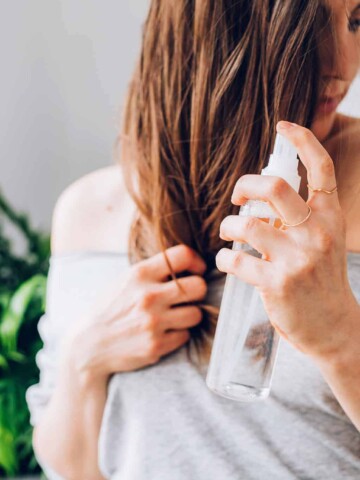This light moisturizing scalp serum contains hair-boosting herbs like fenugreek, peppermint, rosemary, and saw palmetto. Massage it into the scalp to create a tingling, cooling sensation that can soothe irritation and help boost hair growth. And since it’s water-based, you don’t have to worry about it causing an oily scalp!

Yes, there’s an herb for everything. Oily hair? Split ends? Frizz? Yep, there are herbs for those hair woes. One you might not think about putting on your hair, though, is fenugreek.
But just like this herb soothes skin irritation, it can also soothe and nourish your scalp. Plus, it’s a natural emollient, meaning it locks in moisture to keep your hair soft and shiny.
With perks like that, we just had to turn those nutrient-dense fenugreek seeds into a scalp serum.
Jump to:
Benefits of Fenugreek for Hair
Whether you’ve got thin, frizzy hair or thick, dry hair, fenugreek is an all-around hair helper that’s been used for centuries in—you guessed it—haircare.
It can even help tame stubborn scalp issues if you need that, too. Here are some of fenugreek’s many benefits for hair health:
Promotes Hair Growth
One of fenugreek’s most celebrated benefits is its ability to support hair growth. Rich in proteins, lipids, and vitamins B3 and C [source], fenugreek nourishes the scalp, strengthens the hair follicles, and may even encourage new hair growth, making it perfect for hair loss or thinning.
Prevents Hair Damage
Regular use of fenugreek may help shield your strands from damage caused by environmental stress and styling tools. Thanks to a high antioxidant content, it helps combat free radicals [source], preventing premature aging of the hair and keeping your locks looking lush and vibrant.
Conditions and Moisturizes
Fenugreek is particularly helpful for people with dry or brittle hair because it contains fats, making it a natural emollient [source]. By locking in moisture, a nourishing fenugreek hair serum can help restore softness and shine.
Treats Scalp Issues
From dandruff to scalp irritation, fenugreek addresses a whole bunch of common scalp concerns. Its anti-inflammatory [source] and antimicrobial properties [source] may help soothe an irritated scalp, alleviating itchiness and flakiness while also promoting a healthier scalp.
Scalp Serum Ingredients
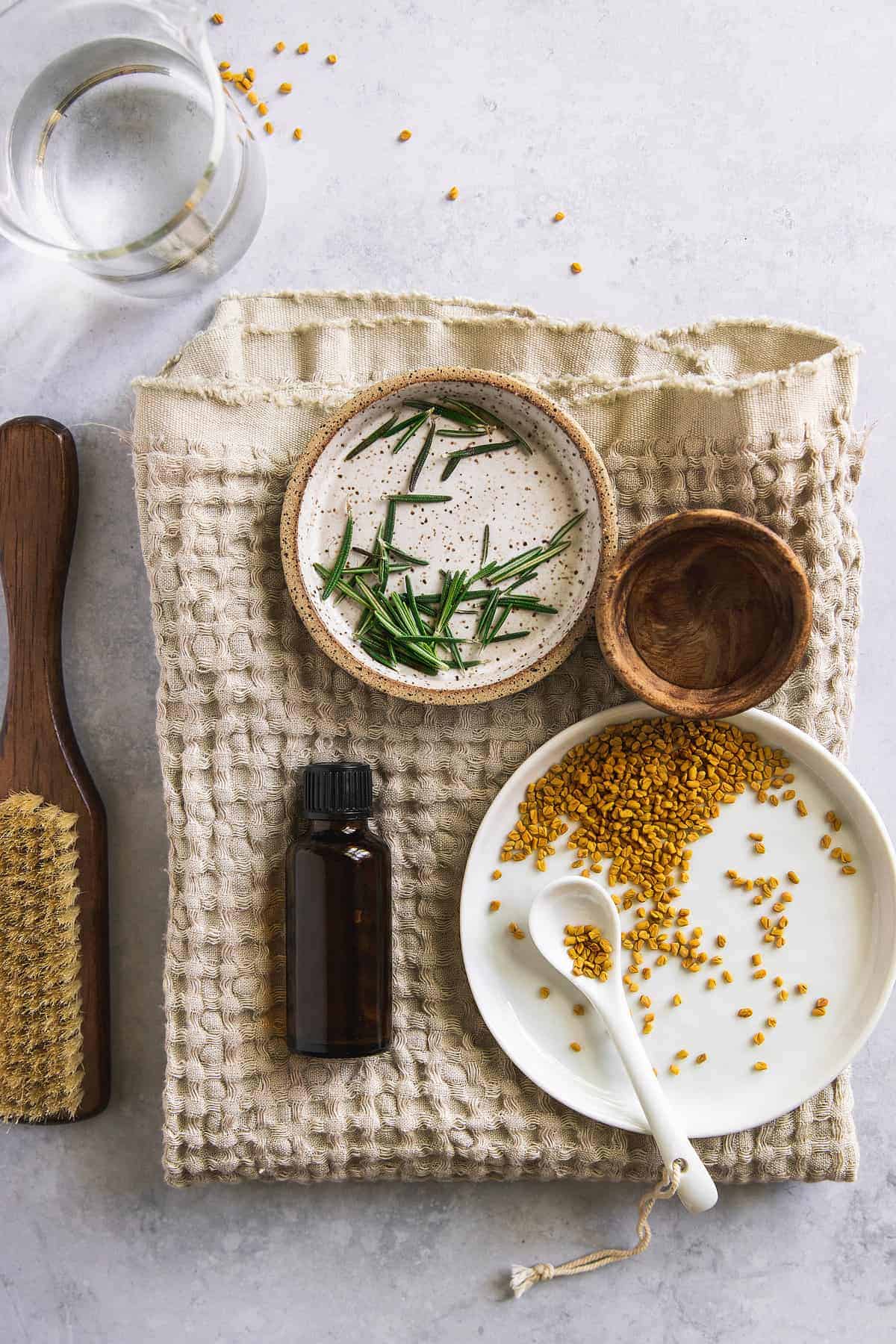
In addition to fenugreek, this hair growth serum contains a whole host of other ingredients to nourish hair follicles:
- Distilled water: No one wants a greasy hair serum that stains their pillow. In place of oil, we use distilled water to provide hydration without weighing hair down or making strands feel oily.
- Fenugreek: The star of the show, fenugreek seed nourishes the scalp, stimulates hair growth, and strengthens the hair shaft, so you end up with healthier, fuller-looking hair.
- Saw palmetto (optional): Saw palmetto may help combat hair loss by inhibiting the hormone responsible for shrinking hair follicles, potentially slowing down the hair thinning process [source].
- Rosemary: Another hair-growth superstar, rosemary oil has been shown to promote hair growth [source]. This pungent herb helps strengthen hair follicles and boosts scalp health thanks to its antioxidant and anti-inflammatory properties.
- Peppermint essential oil: Peppermint essential oil is cooling and invigorating. It contains menthol, which stimulates blood circulation in the scalp, promoting hair growth [source], while its antibacterial properties help maintain scalp health and ward off dandruff [source].
- Xanthan gum: Acts as a natural thickening agent, making this serum easier to apply to the hair and scalp.
- Vegetable glycerin: Glycerin is a natural humectant that draws moisture into the hair and helps prevent dryness and brittleness.
- Preservative: A good preservative is essential for extending the shelf life of this fenugreek hair growth serum and preventing mold growth.
Instructions
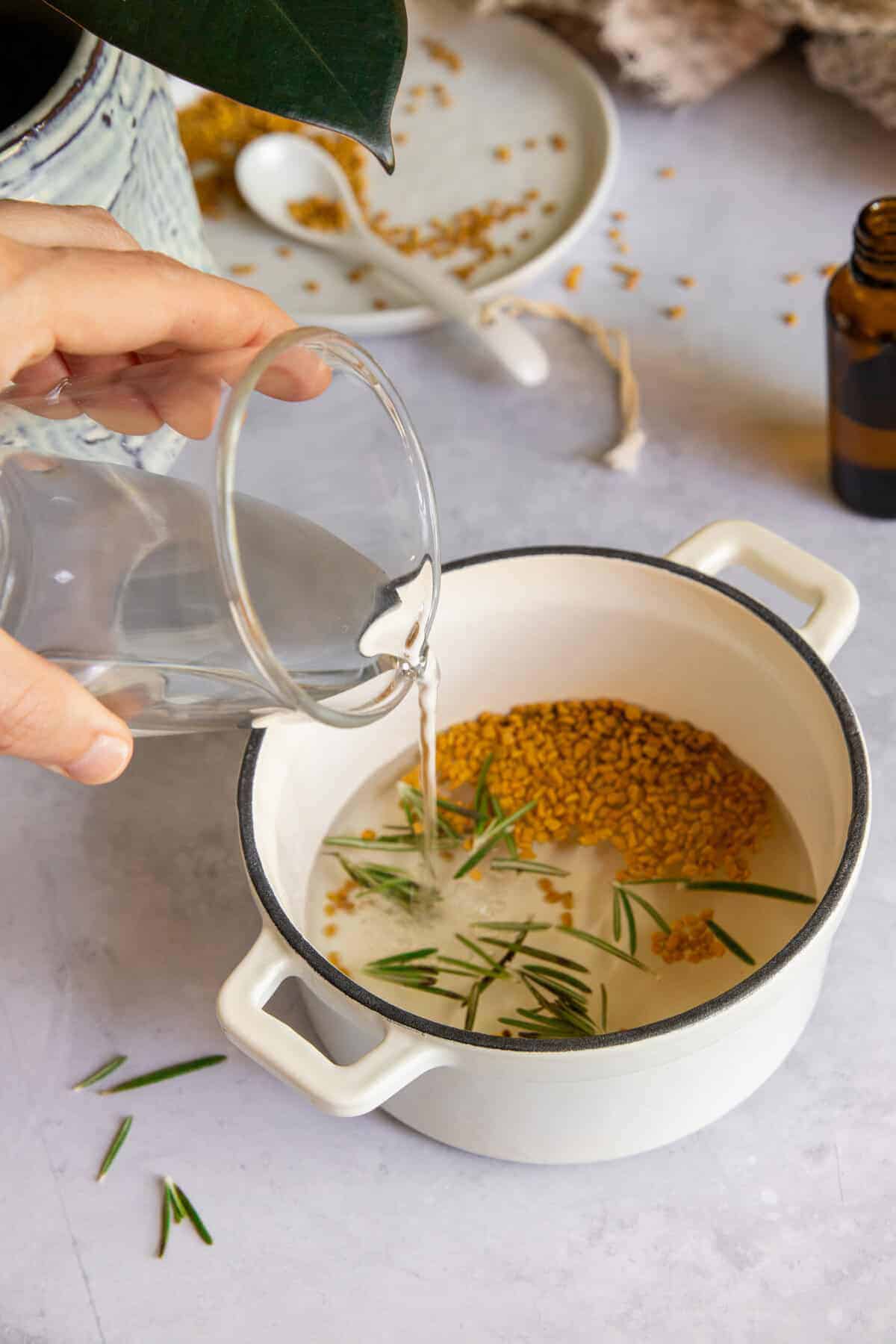
Step 1: Make the Fenugreek Infusion
Begin by combining the distilled water with the fenugreek seeds, rosemary, and saw palmetto in a small pot. Heat the mixture on low for 10–15 minutes, keeping the water hot but not boiling. This will extract the beneficial compounds from the seeds and herbs without damaging them.
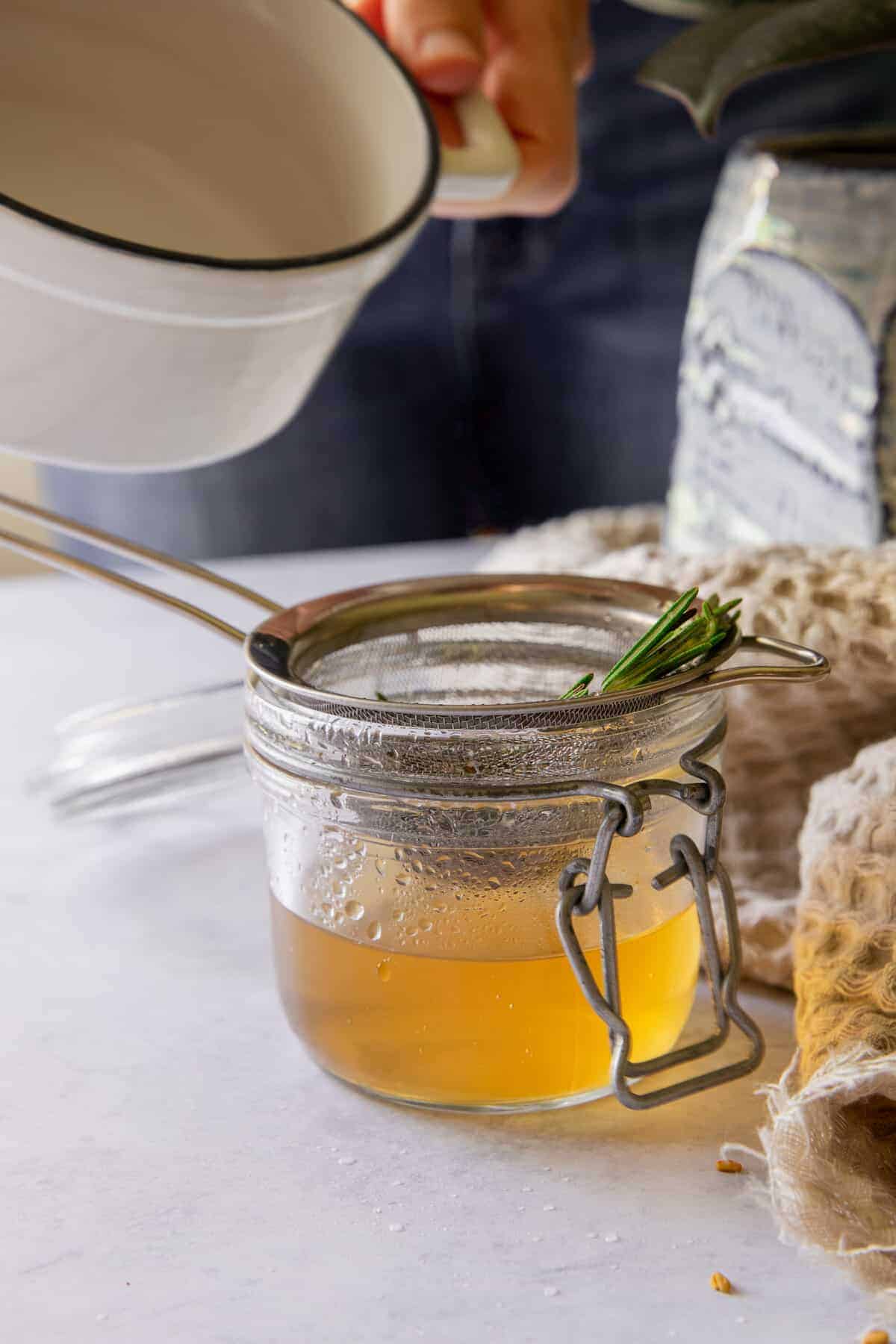
Step 2: Strain Out the Herbs
Let the fenugreek infusion cool before straining out the seeds and herbs. That should leave clear, fenugreek-infused water with no solid particles to clog your bottle. A little saw palmetto powder may be left over, but that’s okay.
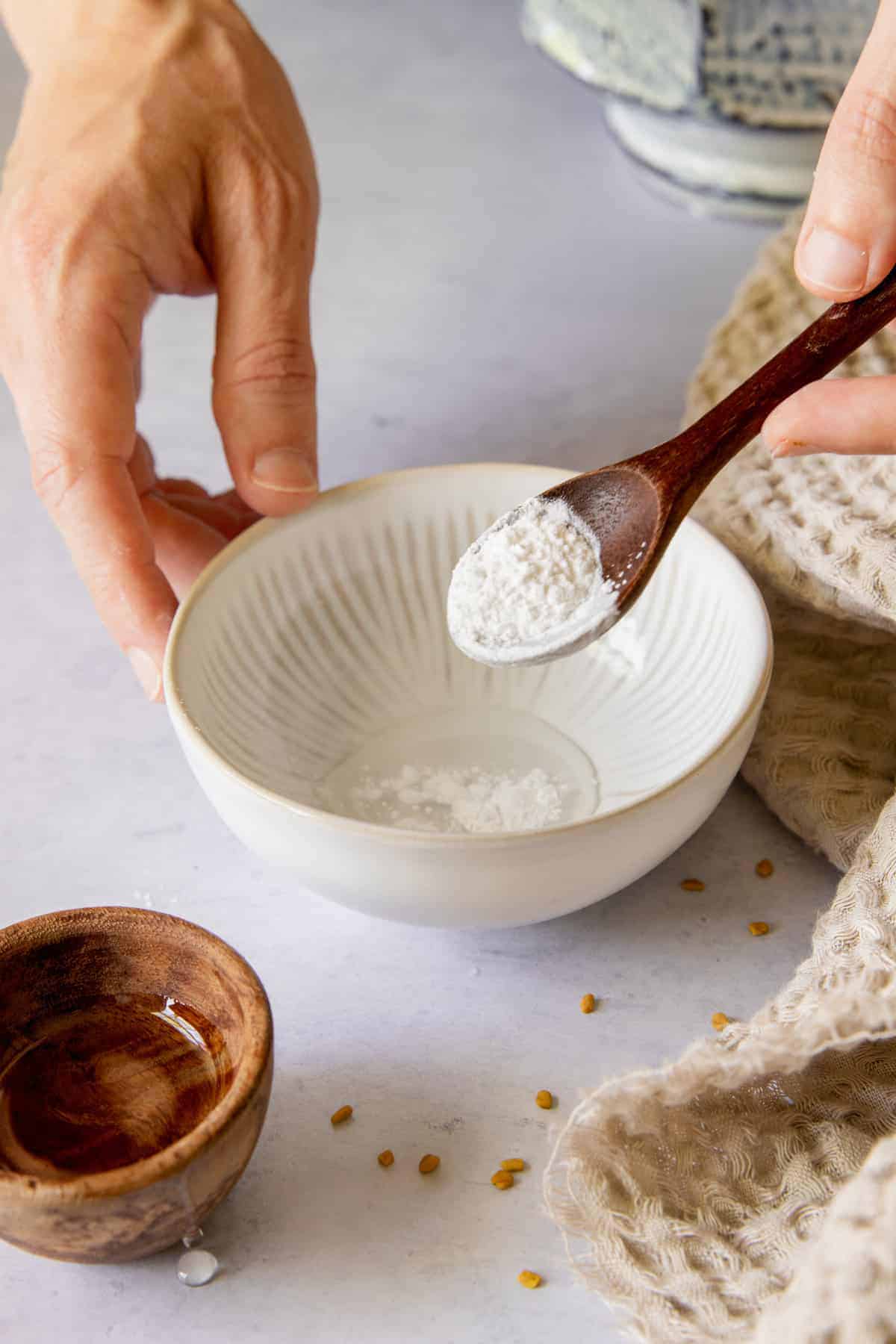
Step 3: Mix Glycerin and Xanthan Gum
In a separate bowl, combine the xanthan gum and vegetable glycerin and stir until the mixture forms a smooth paste.
Xanthan gum acts as a natural thickener, giving the mixture a slightly more serum-like consistency, while vegetable glycerin provides hydration without leaving a greasy residue.
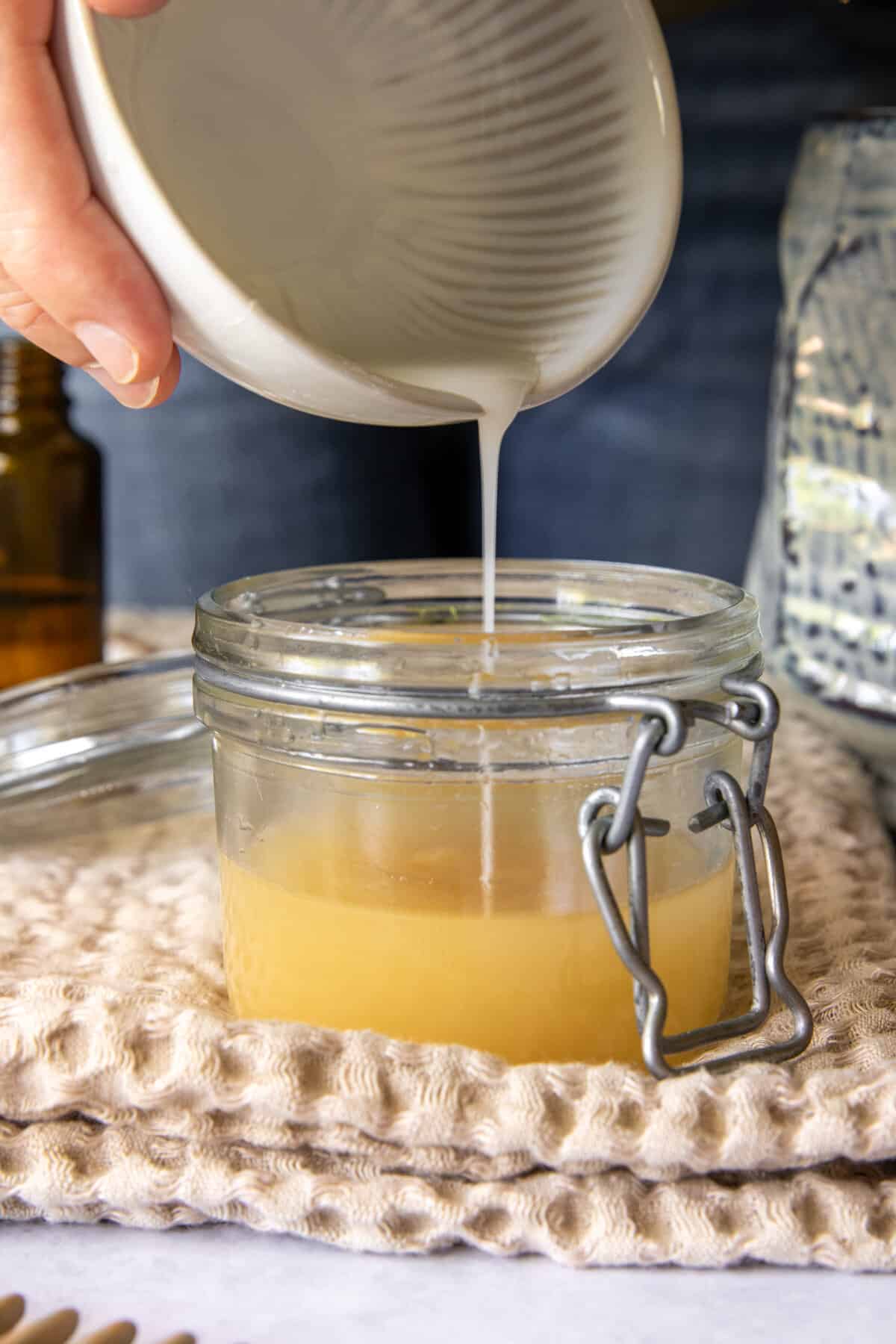
Step 4: Combine Fenugreek and Glycerin Mixtures
Gradually add the fenugreek-infused water to the xanthan gum mixture, stirring continuously to prevent clumping.
If you find the mixture too watery, feel free to add more xanthan gum until it reaches the desired consistency.
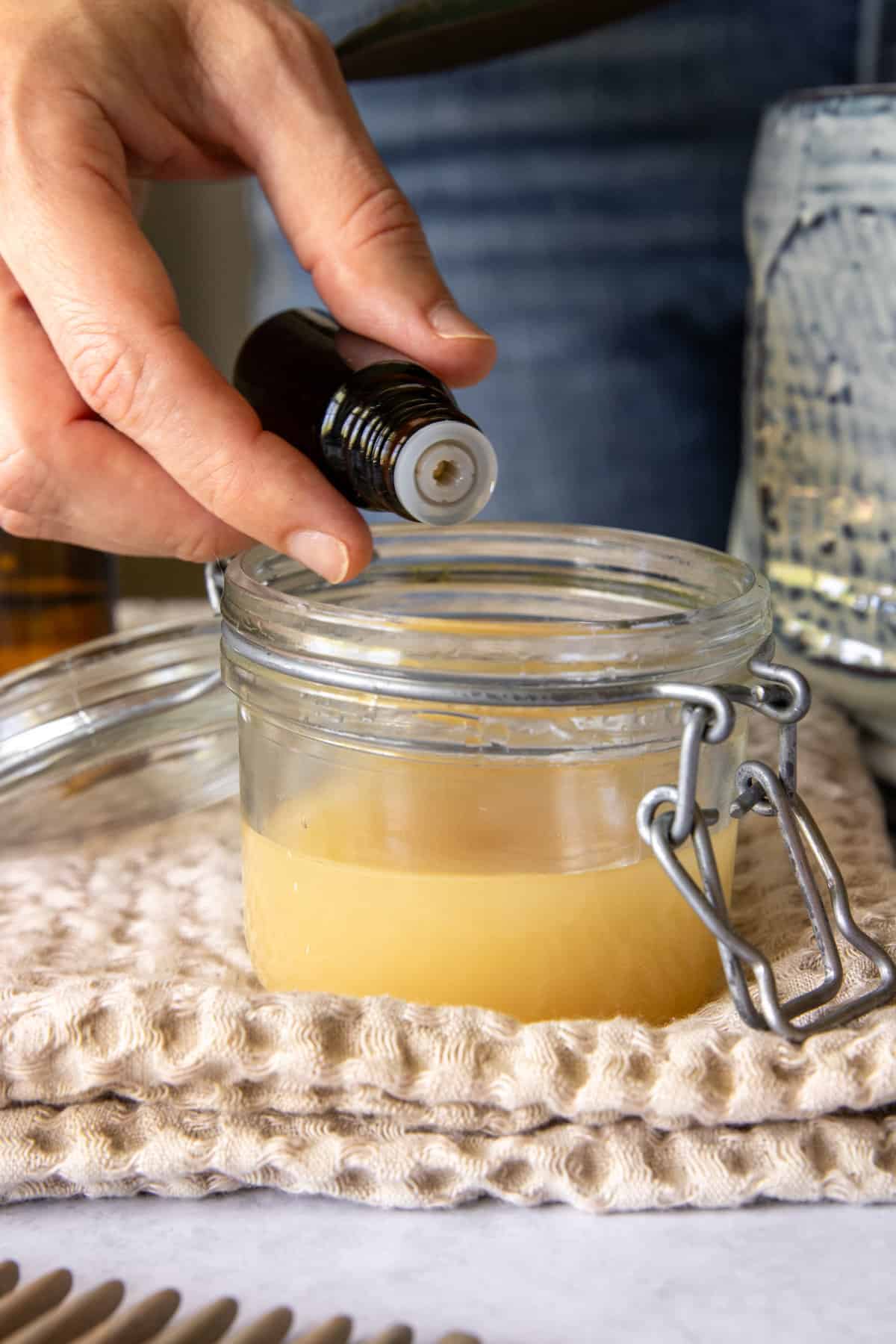
Step 5: Add Essential Oil and Preservative
Add the peppermint essential oil and a preservative to prolong the shelf life of your serum and prevent bacterial and mold growth.

Step 6: Transfer to a Clean, Dry Dropper Bottle
Carefully pour your finished serum into a sterilized glass dropper bottle and store it in a cool, dry place.
Herbal Substitutions
If you can’t get your hands on fenugreek, or you’d just like to play around with other hair-boosting herbs, there are several alternatives:
- Flaxseed: Rich in omega-3 fatty acids and antioxidants [source], flaxseed has the potential to promote hair growth, strengthen hair follicles, and impart shine to the hair. If you use flaxseed, just know that it takes on a gel-like consistency when combined with water, so you may not need to add xanthan gum.
- Burdock root: Known for its anti-inflammatory and detoxifying properties, burdock root has been said to stimulate hair growth [source], reduce scalp irritation, and help maintain a healthy scalp environment.
- Amla: Amla is loaded with vitamin C and antioxidants [source] that can nourish the scalp, strengthen hair follicles, and prevent premature graying while promoting shiny, lustrous hair.
- Hibiscus: Rich in vitamins and amino acids, hibiscus strengthens hair roots, prevents hair fall, and conditions the hair, leaving it soft and manageable.
How To Use a Homemade Scalp Serum
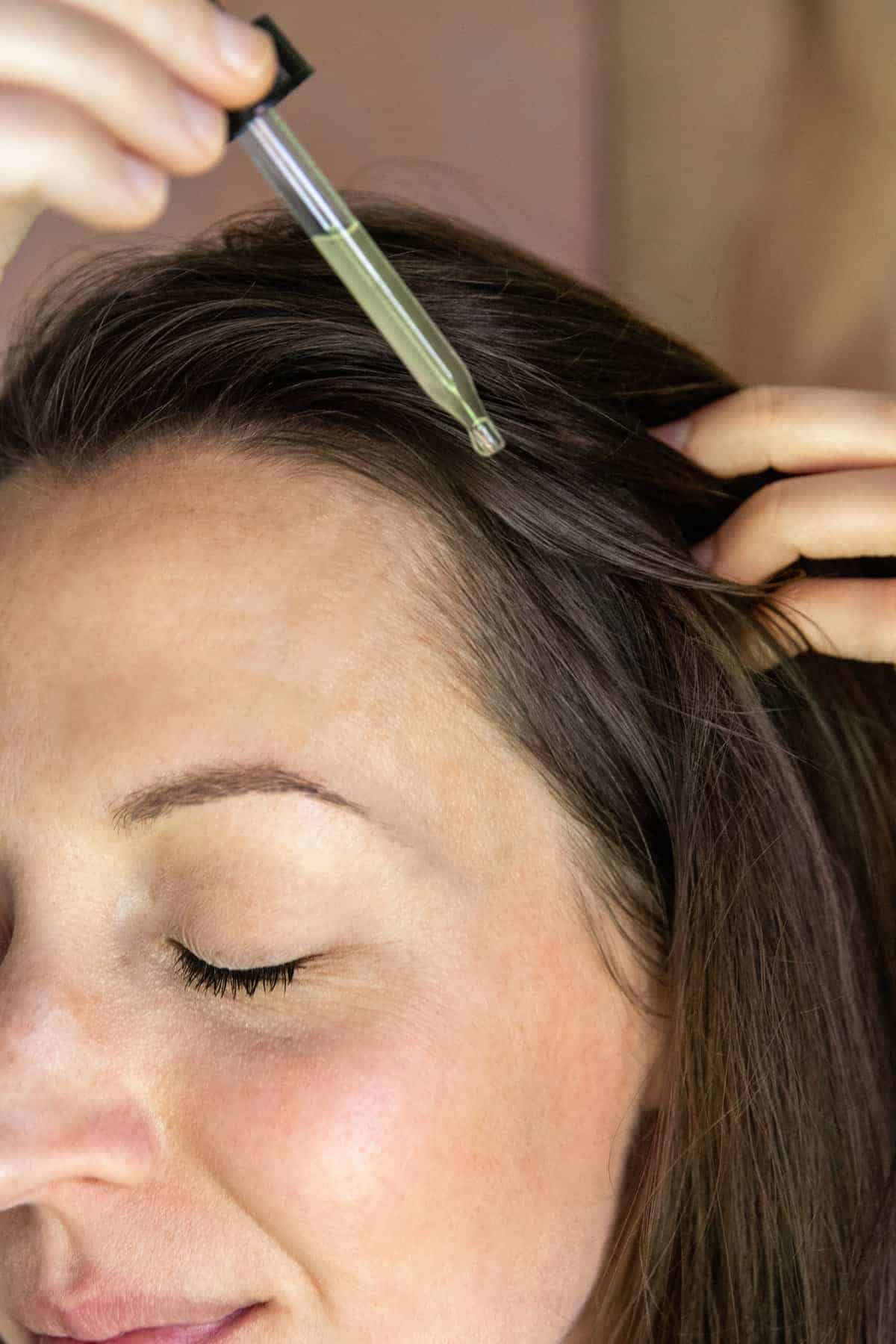
Start with clean hair: For best results, use a gentle shampoo first to remove any dirt, oil, or product buildup. Then towel dry your hair, removing as much moisture as you can.
Alternatively, you can apply the serum to dry hair if you’re short on time or if you don’t use a ton of hair products that might interfere with the serum.
Apply the serum: Divide hair into 4 sections to help you apply the serum evenly. Using the dropper, apply a dime-sized amount of serum to each section, focusing on areas where you notice thinning.
Massage your scalp: Take a few minutes to massage your scalp, using circular motions and gentle pressure to help improve circulation. The massaging action helps improve blood circulation, boosting hair growth. Your scalp should feel a cooling, tingling sensation.
Leave it on overnight: For maximum effectiveness, leave the serum on overnight. This gives you ample time for the nutrients to sink in and nourish your hair follicles.
Rinse or style as usual: In the morning, rinse or wash your hair with lukewarm water to remove any residue, and proceed with your regular hair care routine.
Consistency is key: Incorporate the use of the fenugreek hair growth serum into your hair care routine regularly, ideally 2–3 times per week. Monitor any changes in hair growth, thickness, and overall scalp health.
Adjust the frequency of use or ingredients as needed to suit your individual needs and preferences.
More Ways To Use Fenugreek for Hair + Scalp
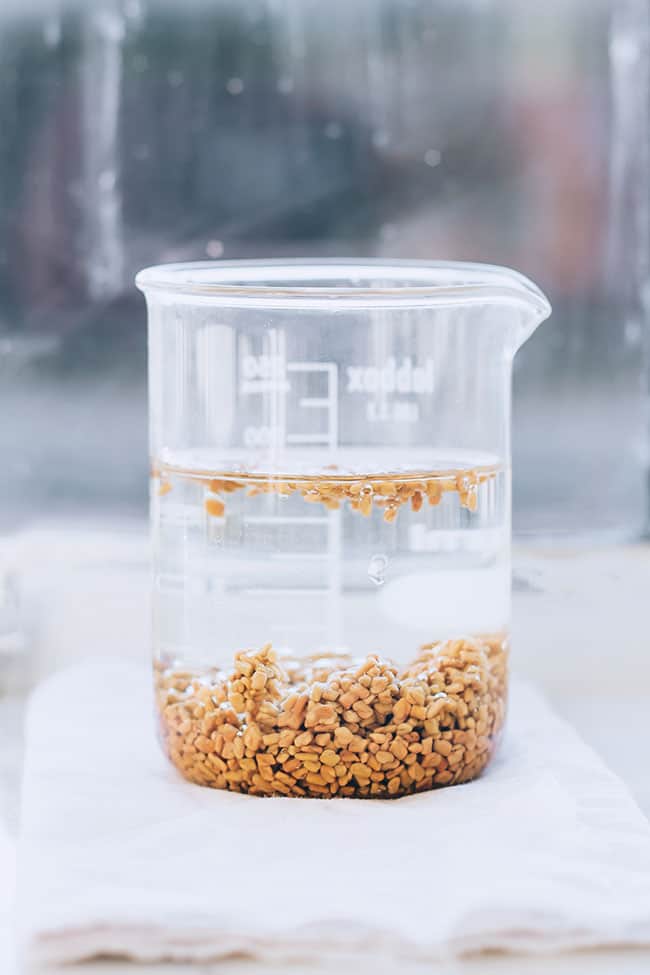
Fenugreek Scalp Oil: If you’d rather have an oil-based product, follow these infusion instructions and use the oil to massage your scalp and hair before going to bed. Wash your hair in the morning.
Dry Scalp Balm: Use fenugreek-infused oil with dry scalp essential oils for a hydrating balm that reduces a flaky scalp.
Thinning Hair Mask: Try a fenugreek hair mask to spark new hair growth. Soak two tablespoons of fenugreek seeds in water overnight. The next day, grind them into a paste. You can add a little water if the paste is too thick.
Apply this mask to your scalp and hair. Leave it on for about 30 minutes before washing it off with mild shampoo.
Scalp Soothing Hair Rinse: Boil a handful of fenugreek seeds in water for about 15 minutes. Let the water cool down, and strain the seeds out.
Use this water as a hair rinse after your regular shampoo routine. It can be a great remedy for scalp irritation and dandruff.
Softening Fenugreek Conditioner: Mix ground fenugreek seeds (or fenugreek seed powder) with yogurt or aloe vera gel to make a smooth paste. Apply this mixture to your hair and scalp.
Leave it for about 20–30 minutes before rinsing off with cool water. This conditioner is particularly good for bringing back softness and bounce to your hair.
FAQ
Use fenugreek consistently for a month, and you should start to notice improvements in hair texture and a reduction in hair fall. Hair growth can take longer to become noticeable, usually around 3 to 6 months.
The pros recommend using a fenugreek hair serum 3 to 4 times a week. But really, it depends on personal preference and how your hair and scalp respond to it. Some people may choose to use fenugreek treatments weekly or biweekly as part of their hair care routine, while others may prefer less frequent use.
Apply fenugreek paste, infused serum, or infused oil directly to the scalp, massaging gently to stimulate circulation in the scalp.
Rosemary + Fenugreek Scalp Serum Recipe
Equipment
- 4-ounce Dropper bottle
- Small saucepan
- Small bowl
Materials
- 1 tablespoon fenugreek seeds
- 1 tablespoon saw palmetto extract optional
- 1 tablespoon dried rosemary leaves
- 5 drops peppermint essential oil or rosemary essential oil
- 2 teaspoons xanthan gum
- 1 tablespoon vegetable glycerin
- 4 ounces distilled water
- 1 teaspoon preservative such as optiphen plus or germaben II
Instructions
- In a small pot, combine distilled water with fenugreek seeds, saw palmetto extract (if using), and rosemary leaves. Heat on low for 10-15 minutes (the water should be hot but not boiling).
- Allow the mixture to cool, then strain out the seeds and herbs. You should be left with a fenugreek-infused water.
- In a separate bowl, combine xanthan gum with vegetable glycerin. Mix well to form a smooth paste.
- Combine the fenugreek-infused water and the xanthan gum mixture, stirring continuously to prevent clumping.
- Once the mixture is well combined, add peppermint essential oil and the preservative.
- Transfer the serum to a clean, sterilized glass bottle with a dropper or pump dispenser for easy application.
Notes
References
- Ahmad A, et al. Fenugreek a multipurpose crop: potentialities and improvements. Saudi J Biol Sci. 2016.
- Pundarikakshudu K, et al. Anti-inflammatory activity of fenugreek (Trigonella foenum-graecum Linn) seed petroleum ether extract. Indian J Pharmacol. 2016.
- Sindhusha VB, et al. Preparation and evaluation of antimicrobial property and anti-inflammatory activity of fenugreek gel against oral microbes: an invitro study. Cureus. 2023.
- Evron E, et al. Natural hair supplement: friend or foe? Saw palmetto, a systematic review in alopecia. Skin Appendage Disord. 2020.
- Natarelli N, et al. Integrative and mechanistic approach to the hair growth cycle and hair loss. J Clin Med. 2023.
- Oh JY, et al. Peppermint oil promotes hair growth without toxic signs. Toxicol Res. 2014.
- Camele I, et al. Chemical composition and antimicrobial properties of Mentha × piperita cv. ‘Kristinka’ essential oil. Plants (Basel). 2021.
- Goyal A, et al. Flax and flaxseed oil: an ancient medicine & modern functional food. J Food Sci Technol. 2014.
- Skowrońska W, et al. Arctium lappa and Arctium tomentosum, sources of Arctii radix: comparison of anti-lipoxygenase and antioxidant activity as well as the chemical composition of extracts from aerial parts and from roots. Plants (Basel). 2021.
- Gul M, et al. Functional and nutraceutical Significance of amla (Phyllanthus emblica L.): a review. Antioxidants (Basel). 2022.






